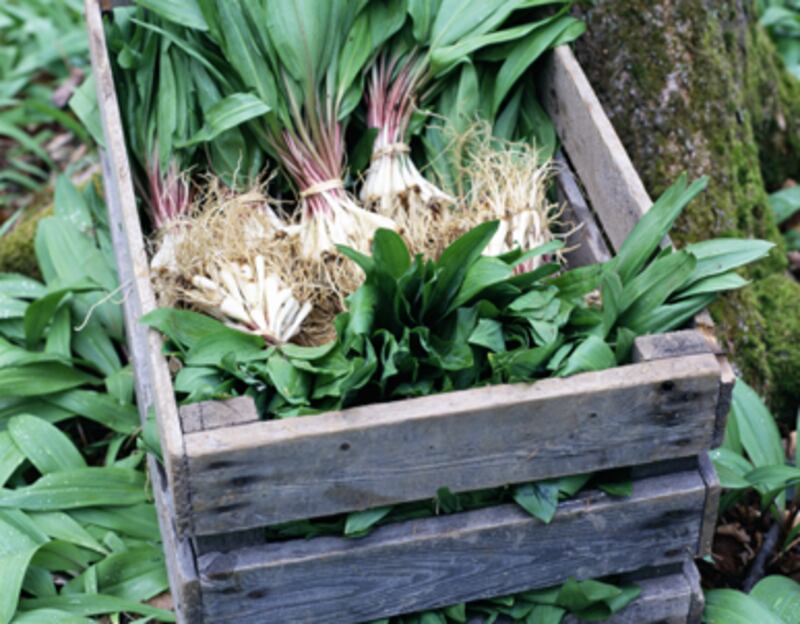The ramp, wild onion of myth and mystery, makes its appearance this month, kicking off the season of forageable greens and delighting seasonal menu fetishists. A harbinger of spring, the heart of ramp season is from mid-April to mid-May, making for a short but much anticipated window for chefs and ramp enthusiasts alike.
The ramp, which grows wild and abundant in New York's Hudson Valley, is sometimes called a wild leek and is a wild onion native to North America. Early in the season, when the ramp is still young, its green leaves are similar to lily of the valley, and a bulb has not yet formed at the base of the stalk. By May, its bulb can grow as big as two centimeters, and turns pink and then a deep red as it matures. As the plant's leaves themselves fall back, a flower stalk emerges, producing small, white flowers by the middle of summer.
Used raw, cooked, or pickled, ramps add a uniquely pungent, seasonal flare. Ramps work well anywhere an onion might, but are frequently found in and alongside eggs and fish or in broths and soups. Pickled ramps are possibly the best-known preparation and are best served with roasted meats, fish, or pasta.
The ramp can be found growing in dense patches in rich, moist, deciduous forests, often along creeks or rivers, from as far north as Canada and south to North Carolina and Tennessee. Ramps were considered a tonic because they provided necessary vitamins and minerals following long winter months without any fresh vegetables, and traditions evolved around the annual gathering and preparation of the pungent plant. Throughout the mountains of the eastern U.S., annual spring ramp festivals are common, so do some research and find the one closest to you to fulfill all of your ramp desires. Below are a few recipes to get you in the mood for ramp season:
Pickled Ramps
Ingredients: 1 cup white wine vinegar 1 cup sugar 1 cup water 1 teaspoon mustard seed 1 teaspoon coriander seed 1 teaspoon red peppercorns 1 bay leaf 2 pounds ramps, cleaned and trimmed Kosher salt for blanching 1 tablespoon salt for the pickling liquid
Trim the ends off the ramps and cut down the leaves, leaving about 1/4 inch of green, saving the green ends for another purpose. Wash the ramps under cool, running water. Drain the ramps well and place them in a Mason jar. Combine the vinegar, salt, sugar, and water in a saucepan and bring to a boil. Add the bay leaf, mustard seeds, coriander, pink and white peppercorns, and fennel seeds. Pour the hot vinegar mixture over the ramps in the jar and let cool, sealing tight and transferring to the refrigerator.
Note: In the refrigerator, these pickled ramps will last a few weeks to a couple of months. If you follow traditional, safe canning techniques, these will last for a few months, or until you eat them all, which ever comes first.
This recipe was adapted from one originally pubilshed by Raphael Brion at SeriousEats.com.

Ramp Pesto
Ingredients: 1 bunch ramps (leaves only, blanched) ¼ cup olive oil 2-3 garlic cloves lemon zest (to taste) soy sauce (to taste) crushed red pepper flakes (to taste) pinch of salt your favorite hot sauce (to taste)
To blanch the ramp leaves (this sets their color and tenderizes them, making it easier to process them in the blender): Drop the leaves into boiling salt water and cook until tender. Plunge ramps into an ice bath to stop the cooking. Coarsely chop the blanched ramp leaves and add to a blender with the garlic, salt, red pepper flakes and about 1/4 cup of olive oil. Start blending, adding 1/4 cup oil to every 2 cups of blanched ramps you add to the blender. The result should be a nice thick puree. Adjust seasoning and add hot sauce to taste. If you're going to freeze the pesto, this is the point where you'll want to stop, put it in small containers (or an ice cube tray) and freeze it (cheese doesn't freeze well, so that should be added when you thaw it back out). Add soy sauce and lemon zest and blend a bit more to finish. Serve over pasta.
Roasted Scallops Wrapped in Ramps
Ingredients: Fresh scallops 1 bunch ramps
Take the ramp greens, blanch them in hot boiling salted water, and shock them in ice water (as with the pesto above). Wrap the ramps around little pieces of scallop and sauté them, being sure to not overcook the fish (it should be translucent in the center and more opaque on the outside).
If you are in the Hudson area, make sure to check out the first ramp festival to be held in the state of New York on Saturday, April 30, 1 to 5 p.m. The ramp will be at the center of original dishes created by chefs from upstate New York and the big city at the festival, to be held at the historic Basilica Hudson, the last great 19th-century building on the Hudson waterfront. More information can be found at www.rampfesthudson.com.
Editor's Note: This article was updated to give credit to SeriousEats.com for the pickled ramps recipe.
Plus: Check out Hungry Beast for more news on the latest restaurants, hot chefs, and tasty recipes.
Jeff Gimmel runs Swoon Kitchenbar with his wife, Nina, in Hudson, New York. After attending Johnson & Wales in Providence, Rhode Island, he became a chef in Newport. He studied in the south of France with acclaimed chef Roger Verge at Le Moulin De Mougi, and returned to Manhattan as chef and partner of the French-American bistro Savann Est, before becoming executive chef of the Midtown institution Michael's. At Swoon, Jeff is an avid supporter of the local sustainable agriculture movement, and pursues his passion for organic/naturally grown produce, poultry, meats, and seafood.






